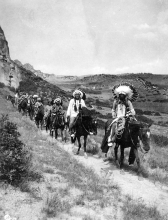The City of Colorado Springs recognizes the second Monday in October as Indigenous Peoples Day. As we celebrate this day, we reflect on the history and future of Native American groups in the Pikes Peak Region.
At least 48 federally recognized tribes have deep connections here and continue to foster their relationships with this land. These tribes include, but are not limited to, the Ute, Kiowa, Jicarilla Apache, Comanche, Cheyenne, and Arapaho.
For years, the City of Colorado Springs has partnered with multiple Native American tribes through our Parks, Recreation, and Cultural Services Department. On a regular basis, official tribal representatives are consulted with ahead of construction projects and other alterations made to many of our regional parks and open spaces. As the original stewards of this land, our Native American partners continue to care for many of the places that are important to people far and wide.
The City of Colorado Springs has most frequently partnered with the three Ute Tribes. Long before there was a City of Colorado Springs, this region was Ute Homeland. Utes are the longest continuous residents of what is now known as Colorado. While Colorado Springs lies within Ute ancestral homelands, the city only comprises a small portion of Ute territory that covered over 200,000 square miles. Ute people are descendants of ancestral hunter-gatherers who inhabited this area for more than 14,000 years. Ute oral histories identify the Rocky Mountains, surrounding basins, and plains as traditional homelands.
Join us as we celebrate Indigenous Peoples Day here in Colorado Springs – the home to many Native American groups and individuals. These people remain dedicated stewards of their sacred homelands and continue to contribute to the existing culture of the Pikes Peak Region.
- 1912 Ute Pass Trail Dedication; Courtesy of the Colorado Springs Pioneers Museum
- 1894 Ute Encampment in the Broadmoor Area, From left to right: Capitaneto, Piah, Severo, Natz-chi-ve-rat, and Isareta; Courtesy of the Colorado Springs Pioneers Museum

